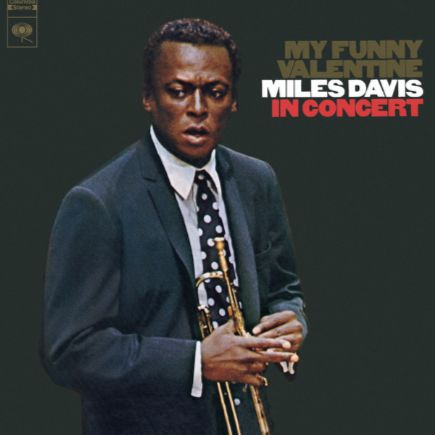My Funny Valentine: l’ironie tendre d’un amour sans fard
Créée en 1937 pour la comédie musicale Babes in Arms de Richard Rodgers et Lorenz Hart, My Funny Valentine était à l’origine un simple numéro de théâtre interprété par la jeune star Mitzi Green. Le spectacle connut un succès notable à Broadway avec près de 300 représentations, mais c’est bien la chanson qui allait traverser les décennies pour devenir l’un des standards les plus enregistrés du jazz (plus de 1300 versions recensées, par plus de 600 artistes).
Ballade mélancolique à la fois douce et désarmante, My Funny Valentine séduit par l’ambiguïté de son texte: Lorenz Hart y brosse le portrait d’un être imparfait, voire maladroit, mais profondément aimé pour ce qu’il est. Le charme du morceau réside dans ce mélange de tendresse, d’ironie et d’authenticité, porté par une mélodie élégante et légèrement mélancolique. Les paroles, volontairement neutres, permettent une interprétation universelle, indépendante du genre ou du contexte.
Un souffle suspendu au Philharmonic Hall
Le 12 février 1964, Miles Davis et son quintette livrent au Philharmonic Hall de New York une interprétation bouleversante de My Funny Valentine, captée en direct lors d’un concert de charité au profit des droits civiques. Parue sur l’album éponyme, cette version reste l’un des moments les plus intenses et introspectifs du jazz en public, où émotion et maîtrise technique fusionnent avec une rare puissance expressive.
Miles Davis est entouré d’une formation exceptionnelle: George Coleman au saxophone ténor, Herbie Hancock au piano, Ron Carter à la contrebasse et Tony Williams à la batterie. Dès les premières notes, le climat est posé: feutré, tendu, retenu. La trompette de Davis, souvent jouée avec sourdine, semble susurrer plutôt que chanter, tissant un discours fragmenté, elliptique, où chaque silence est aussi chargé de sens que les notes elles-mêmes.
George Coleman, dans un jeu plus ancré, offre un contrepoint élégant et contenu, contrastant avec les orages émotionnels que Davis laisse parfois affleurer. Herbie Hancock insuffle dans ses accords une modernité harmonique discrète mais révolutionnaire. Ron Carter, d’une souplesse magistrale, dialogue subtilement avec Tony Williams, alors tout juste âgé de 18 ans, dont la batterie, audacieuse et imprévisible, transforme la ballade en une matière vivante, en perpétuel mouvement.
My Funny Valentine: la tierna ironía de un amor sin artificios
Creada en 1937 para el musical Babes in Arms de Richard Rodgers y Lorenz Hart, My Funny Valentine fue en sus orígenes un simple número teatral interpretado por la joven estrella Mitzi Green. El espectáculo tuvo un éxito notable en Broadway, con casi 300 representaciones, pero fue la canción la que atravesó las décadas hasta convertirse en uno de los estándares más versionados del jazz (más de 1300 versiones registradas por más de 600 artistas).
Balada melancólica, a la vez suave y desarmante, My Funny Valentine cautiva por la ambigüedad de su letra: Lorenz Hart traza el retrato de un ser imperfecto, incluso torpe, pero profundamente amado por lo que es. El encanto del tema reside en esa mezcla de ternura, ironía y autenticidad, sostenida por una melodía elegante y levemente melancólica. La neutralidad deliberada de la letra permite una interpretación universal, independiente del género o del contexto.
Un suspiro suspendido en el Philharmonic Hall
El 12 de febrero de 1964, Miles Davis y su quinteto ofrecieron en el Philharmonic Hall de Nueva York una interpretación conmovedora de My Funny Valentine, capturada en directo durante un concierto de beneficencia por los derechos civiles. Publicada en el álbum homónimo, esta versión permanece como uno de los momentos más intensos e introspectivos del jazz en vivo, donde la emoción y el dominio técnico se combinan con una potencia expresiva poco común.
Miles Davis se encuentra acompañado por una formación excepcional: George Coleman al saxofón tenor, Herbie Hancock al piano, Ron Carter al contrabajo y Tony Williams a la batería. Desde las primeras notas, se impone un clima matizado, tenso y contenido. La trompeta de Davis, a menudo silenciada con sordina, susurra más que canta, tejiendo un discurso fragmentado y elíptico donde cada silencio tiene tanto significado como las notas.
George Coleman, con un estilo más sólido, ofrece un contrapunto elegante y mesurado que contrasta con los arranques emocionales que Davis deja asomar. Herbie Hancock aporta a sus acordes una modernidad armónica discreta pero revolucionaria. Ron Carter, con una flexibilidad magistral, entabla un diálogo sutil con Tony Williams, de apenas 18 años, cuya batería, audaz e impredecible, transforma la balada en un tejido sonoro en constante movimiento.
My Funny Valentine: l’ironia delicata di un amore senza maschere
Creata nel 1937 per il musical Babes in Arms di Richard Rodgers e Lorenz Hart, My Funny Valentine era inizialmente un semplice numero teatrale interpretato dalla giovane star Mitzi Green. Lo spettacolo ottenne un notevole successo a Broadway, con quasi 300 repliche, ma fu la canzone a sopravvivere ai decenni, diventando uno degli standard jazz più registrati (oltre 1300 versioni da parte di più di 600 artisti).
Ballata malinconica, al tempo stesso dolce e disarmante, My Funny Valentine affascina per l’ambiguità del suo testo: Lorenz Hart vi traccia il ritratto di un essere imperfetto, persino goffo, ma profondamente amato per ciò che è. Il fascino del brano risiede in questo intreccio di tenerezza, ironia e autenticità, sorretto da una melodia elegante e lievemente malinconica. Il testo volutamente neutro consente un’interpretazione universale, indipendente dal genere o dal contesto.
Un respiro sospeso al Philharmonic Hall
Il 12 febbraio 1964, Miles Davis e il suo quintetto offrirono al Philharmonic Hall di New York un’interpretazione profondamente coinvolgente di My Funny Valentine, registrata dal vivo durante un concerto di beneficenza per i diritti civili. Pubblicata nell’album omonimo, questa versione rimane uno dei momenti più intensi e introspettivi del jazz live, dove emozione e padronanza tecnica si fondono con una potenza espressiva rara.
Miles Davis è affiancato da una formazione d’eccezione: George Coleman al sax tenore, Herbie Hancock al pianoforte, Ron Carter al contrabbasso e Tony Williams alla batteria. Sin dalle prime note, si crea un’atmosfera velata, tesa e misurata. La tromba di Davis, spesso usata con sordina, sussurra piuttosto che cantare, tessendo un discorso frammentato, ellittico, in cui ogni silenzio ha tanto peso quanto le note.
George Coleman, con un approccio più radicato, offre un contrasto elegante e controllato, in netto contrasto con le turbolenze emotive che Davis lascia emergere. Herbie Hancock infonde nei suoi accordi una modernità armonica discreta ma rivoluzionaria. Ron Carter, con flessibilità magistrale, dialoga con Tony Williams—appena 18 anni—la cui batteria, audace e imprevedibile, trasforma la ballata in una materia sonora viva e in continuo movimento.
My Funny Valentine: the gentle irony of an unvarnished love
Written in 1937 for the musical Babes in Arms by Richard Rodgers and Lorenz Hart, My Funny Valentine was originally just a theater number performed by young star Mitzi Green. The show enjoyed considerable success on Broadway, with nearly 300 performances, but it was the song that would endure through the decades, becoming one of the most recorded jazz standards—over 1300 known versions by more than 600 artists.
A melancholic ballad that is both tender and disarming, My Funny Valentine captivates with the ambiguity of its lyrics: Lorenz Hart paints the portrait of an imperfect, even awkward, person who is deeply loved just as they are. The charm of the piece lies in this blend of tenderness, irony, and authenticity, carried by an elegant, slightly melancholic melody. The deliberately neutral lyrics allow for a universal interpretation, regardless of gender or context.
A suspended breath at Philharmonic Hall
On February 12, 1964, Miles Davis and his quintet delivered a powerful rendition of My Funny Valentine at New York’s Philharmonic Hall, captured live during a civil rights benefit concert. Featured on the eponymous album, this performance remains one of the most intense and introspective live jazz moments, where emotion and technical command intertwine with rare expressive force.
Davis is backed by an extraordinary ensemble: George Coleman on tenor sax, Herbie Hancock on piano, Ron Carter on bass, and Tony Williams on drums. From the opening notes, the mood is subdued, taut, and restrained. Davis’s trumpet, often muted, seems to whisper rather than sing, weaving a fragmented, elliptical narrative where each silence carries as much weight as the notes themselves.
George Coleman, with a grounded style, offers an elegant, contained counterpoint that contrasts with the emotional storms Davis occasionally allows to surface. Herbie Hancock brings a discreet yet revolutionary harmonic modernity to his chordal approach. Ron Carter, with masterful flexibility, engages in subtle dialogue with Tony Williams—only 18 at the time—whose bold and unpredictable drumming turns the ballad into a living, ever-shifting sonic tapestry.


